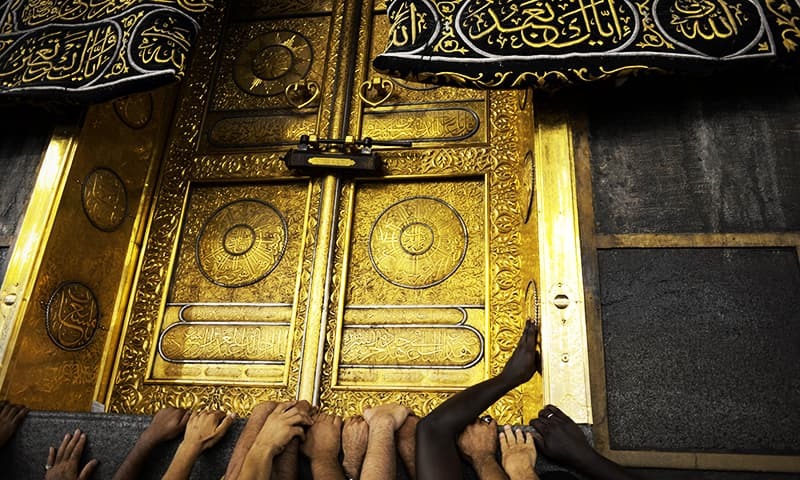MAKKAH: Hundreds of thousands of pilgrims from around the world began moving on Tuesday from the holy city of Makkah to nearby Mina for the start of Haj.
 Almost two million people are expected to take part in this year’s pilgrimage, undeterred by a crane collapse in Makkah earlier this month that killed 109 people and injured nearly 400 at Islam’s holiest site.
Almost two million people are expected to take part in this year’s pilgrimage, undeterred by a crane collapse in Makkah earlier this month that killed 109 people and injured nearly 400 at Islam’s holiest site.
“It is a gift from God that He has chosen us to come here,” said Walaa Ali, a 35-year-old Egyptian pilgrim with tears in her eyes. “I am so happy to be here.”
Nearby, both men and women sat side by side listening to preachers explain the history and rituals of the hajj, one of the world’s largest annual gatherings.
This year’s Haj begins against a backdrop of increased jihadist violence, a surge of the deadly Middle East respiratory syndrome (MERS) virus and with Saudi Arabia at war in Yemen.
The first day of Haj is known as Tarwiah Day, when pilgrims traditionally watered their animals and stocked water for their trip to Mount Arafat, about 10 kilometres southeast of Mina.
Nowadays pilgrims spend their time there in prayer and reciting the Quran.
The climax of Haj season is on Arafat Day, which falls on Wednesday.
With the start of Haj, pilgrims enter ‘ihram’ ─ a state of purity in which they must not wear perfume, cut their nails, or trim their hair or beards.
During ‘ihram’, men wear a seamless two-piece shroud-like white garment, symbolising resurrection and emphasising unity regardless of social status or nationality. Women must wear loose dresses exposing only their faces and hands. They are following the 1,400-year-old tradition of the Prophet Muhammed (peace be upon him).
Haj is among the five pillars of Islam and every capable Muslim must perform the pilgrimage at least once in their life.
Previously marred by stampedes and fires that killed hundreds, it had been largely incident-free for the past decade after safety improvements.
But on September 11, during severe winds, a construction crane toppled into a courtyard of Mecca’s Grand Mosque.
Saudis, Iranians, Nigerians, Malaysians, Indonesians and Indians were among the dead.
‘Terror’ threat
Authorities say they are on the alert for possible attacks by the extremist self-styled Islamic State group, which has carried out bombings targeting mosques in the kingdom in recent months.
Security forces have taken “measures to prevent terrorist groups from exploiting hajj season to carry out acts of sabotage,” said interior ministry spokesman General Mansur al-Turki.
The ministry says 100,000 police have been deployed to secure Haj.
“We take all possibilities into consideration during Haj. This includes the kingdom being targeted by terrorist organisations,” Turki told AFP.
Saudi Arabia is also at war this year, leading an Arab coalition conducting air strikes and supporting local forces in Yemen against Houthi rebels since March.
Most Yemeni pilgrims performing the Haj this year are already residing in the kingdom.
Among other challenges facing Saudi authorities this year is potential transmission of the deadly MERS coronavirus (MERS-CoV). The capital Riyadh saw a jump in infections last month. But health officials have insisted that so far no MERS infections have been recorded among pilgrims.
Saudi Arabia is the country worst affected by MERS, with 528 deaths since the virus appeared in 2012. The health ministry has mobilised thousands of health workers to help secure a virus-free pilgrimage.
Also read: IS attacks in Saudi Arabia raises security concerns for Haj
Haj in numbers
Haj is one of the world’s largest annual gatherings. Here are some figures illustrating its scale:
- Almost 1.4m pilgrims from around the world have already arrived. A total of about 2m, including hundreds of thousands from within the kingdom, are expected.
- The world’s largest Muslim-populated nation, Indonesia, has sent more than 168,000 pilgrims.
- 80 per cent of international pilgrims come in official Haj delegations from their countries. The other 20 pc come with tourism companies.
- About 100,000 police have been deployed to secure Haj, maintain safety of pilgrims, and manage traffic and crowds.
- The health ministry has mobilised 25,000 additional healthcare workers. To care for ailing pilgrims it has 5,000 beds, including 500 for intensive care. There are eight “seasonal hospitals” which complement permanent medical facilities.
- 12 new plasma screens, each more than two metres wide, will broadcast messages to pilgrims outside the Grand Mosque, the Saudi Gazette reported.
- The Grand Mosque is being expanded by roughly 400,000 square metres (4.3-million-square-feet) which is the equivalent of more than 50 football pitches.
- The average spending for every pilgrim coming from abroad is between $4,600 to $5,000 during Haj season, according to Maher Jamal, chairman of the Makkah Chamber of Commerce and Industry.
- 740 fire hydrants and 800 taps are connected to a 100-kilometre water network, helping to ensure fire safety at Mina, where fireproof tents can accommodate 2.6m pilgrims.

